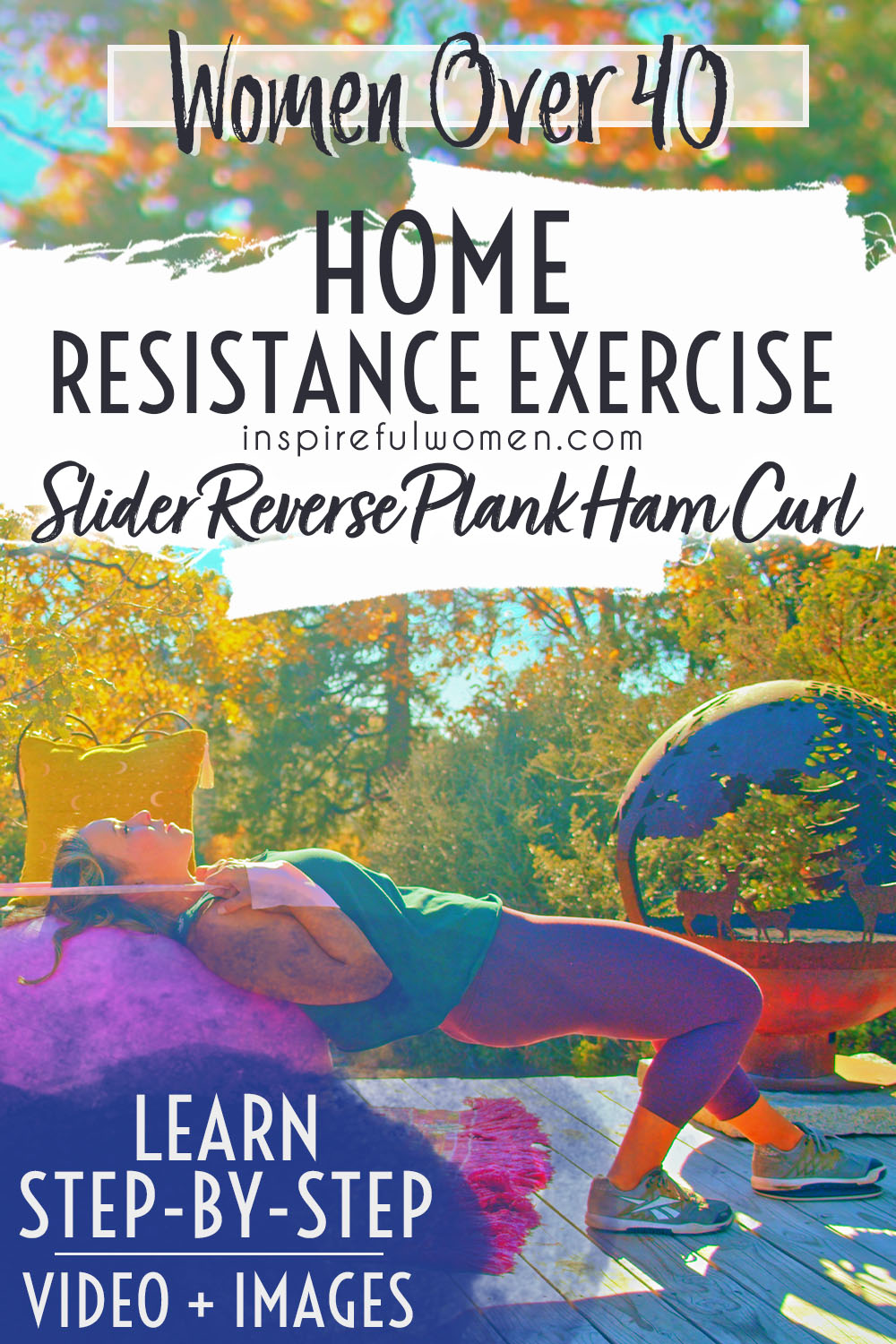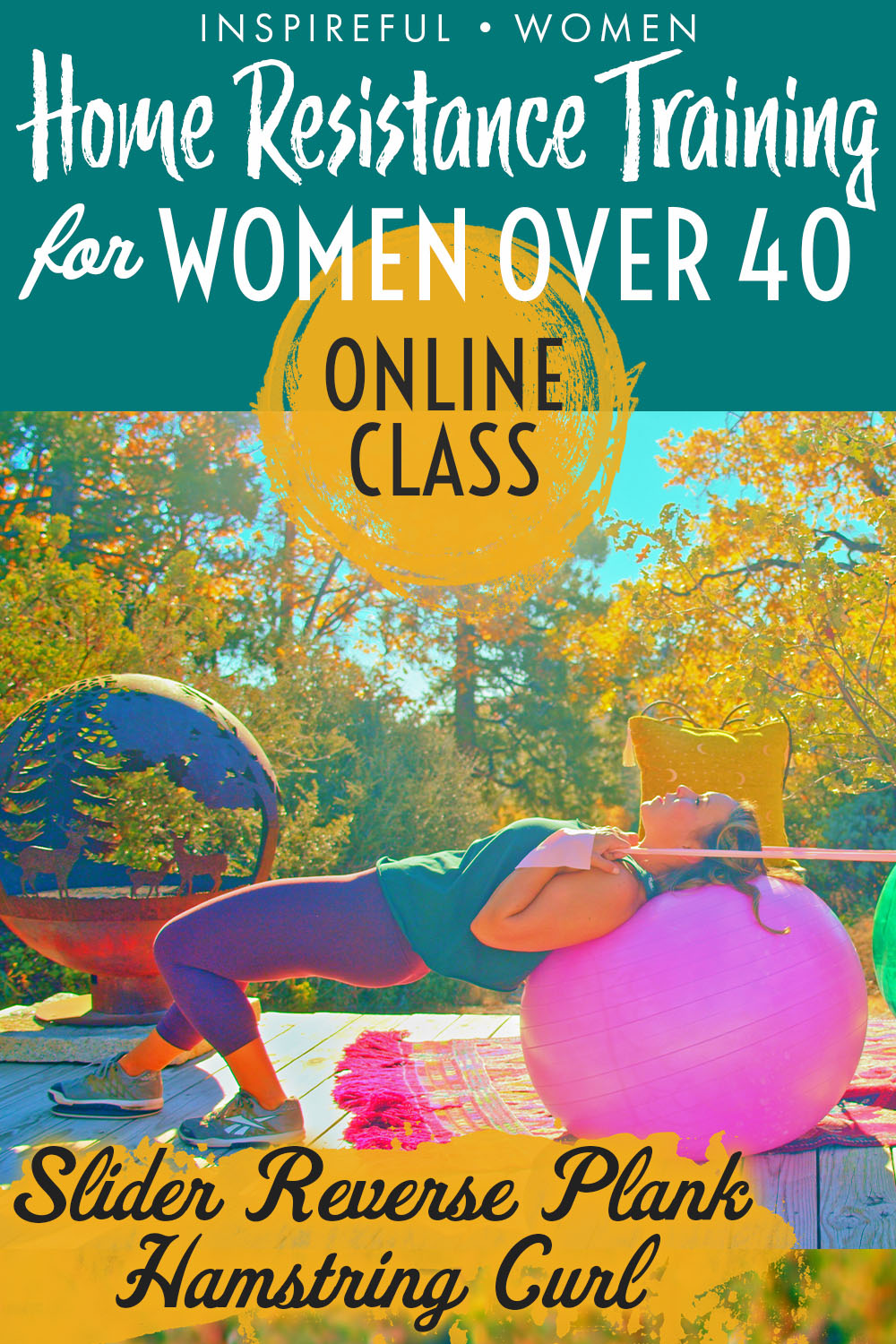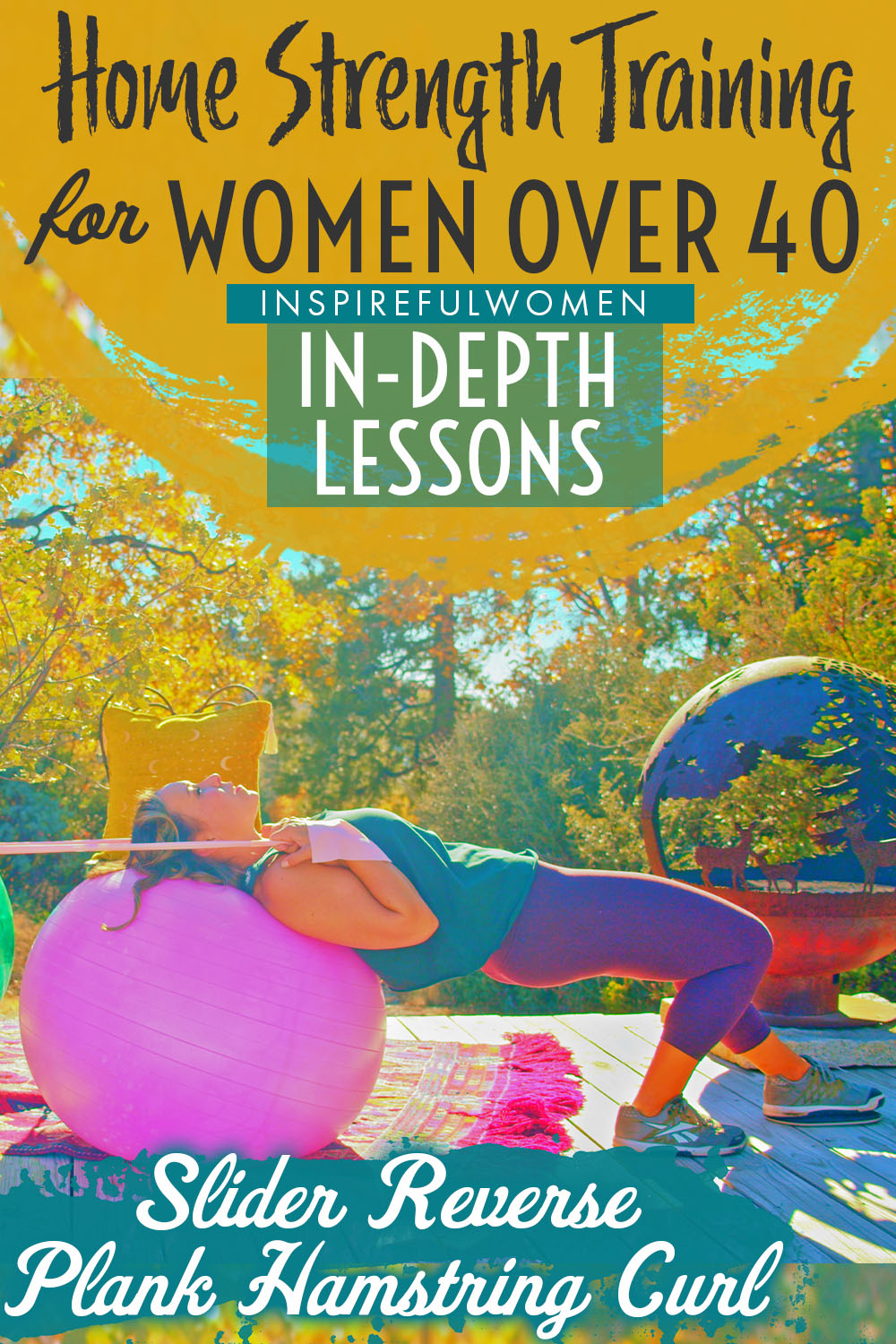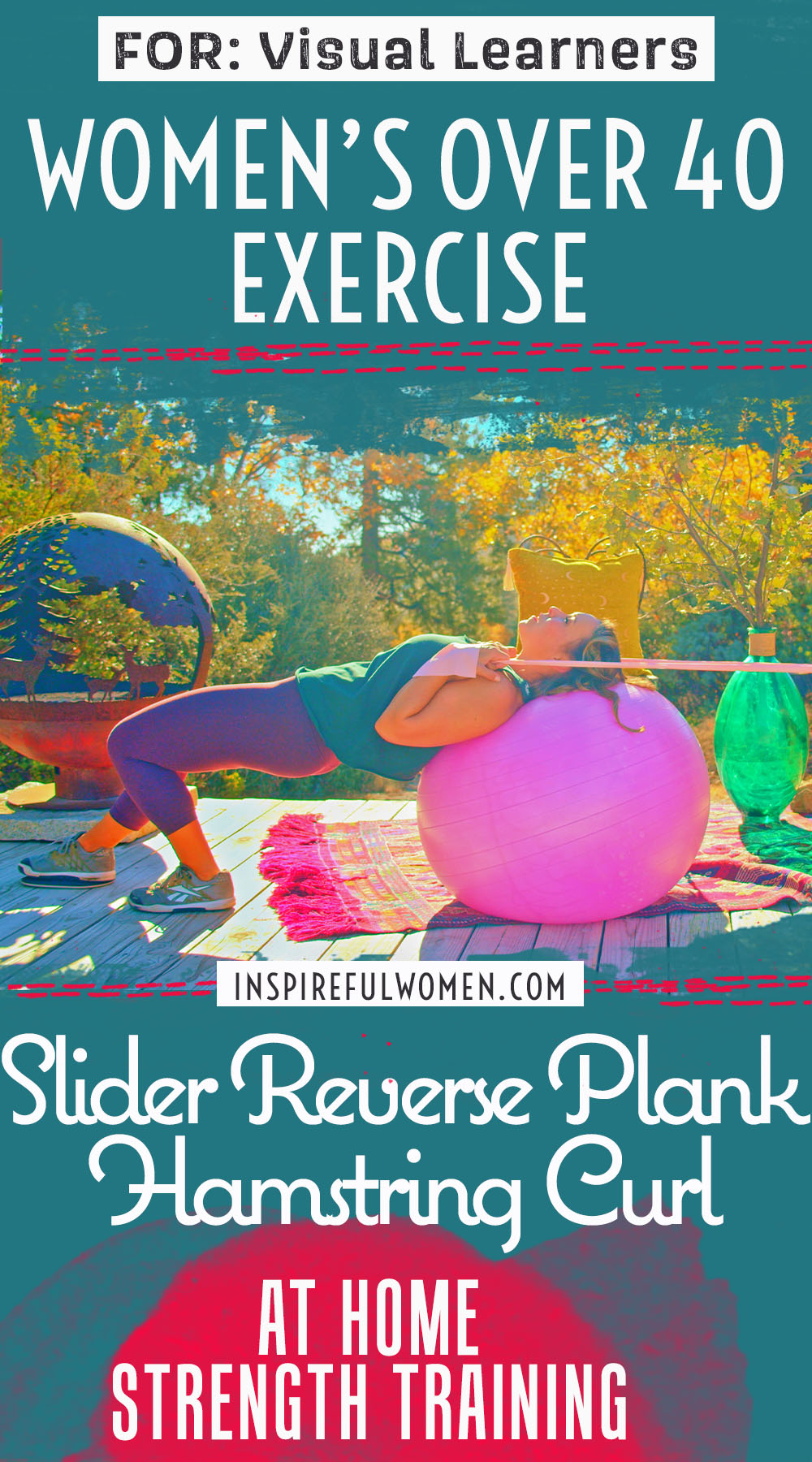Ball Reverse Plank Ham Curl - Slider
How to Do the Swiss Ball Reverse Plank Leg Curl w/ Slider - Hamstring Curl Alternative at Home | In-Depth Guide [VISUAL LEARNERS] Beginner
Proper Form & Common Mistakes | Home Resistance Training

WHAT DO YOU WANT TO SEE?
QUICK DEMO
QUICK DEMO
MUSCLES THIS WORKS
MUSCLES
MAIN MUSCLES WORKED IN BALL REVERSE PLANK HAM CURL - Slider
HAMSTRINGS
OTHER MUSCLES WORKED:
- Gluteus Maximus
- Gastrocnemius
- Core Stabilizers
STARTING POINTERS
Starting Pointers
WHAT WE'RE DOING TODAY
Other names for this exercise: Stability Ball Reverse Plank Hamstring Curl - Slider
This version of Stability Ball Reverse Plank Hamstring Curls is done using a slider under one foot. This version is less difficult than single-leg stability ball reverse plank hamstring curls with the band. It is much easier to stay balanced and stable because both feet have contact with the floor. The leg with the slider under the foot will not be able to help with the hamstring curl as much because of the low friction between the slider and the floor.
HOW TO DO THE EXERCISE
LOOKS
HOW Ball Reverse Plank Hamstring Curls - Slider SHAPE OUR BODY
The exercise will tone the waist and help achieve a flat abdomen. Personal note from me Rayzel here - I know they say abs are really made in the kitchen, but I have noticed a very distinct "smallifying" of my waist (like my new word?) since regularly doing core exercises that specifically work the SIDES of my core, like this one.
PROPER FORM
PROPER FORM: Ball Reverse Plank Hamstring Curl - Slider
EQUIPMENT, SETS & REPS
EQUIPMENT
Main set (3: Light/Med/Heavy)
X-Heavy Band (I recommend getting this too if you plan to use resistance bands frequently).
STABILITY BALL
Tip: It's best to get one that has a slightly textured feel to it, like the pearlescent ones. If they don't have a textured surface, the ball tends to be slippery on the surface (carpet, floor, whatever) and it can come out from under you pretty easily (ask me how I know).
Here are my recommendations that have a textured surface:
One size, many color options. I have one of these at home and it doesn't slip.
Galsports has different size options for the ball which is nice if you are fairly tall or fairly short. Your height will change what size ball will be the best for you. I have one of these in the Large size, which is about the "standard" ball size, and it works well. The small size is too small for our purposes no matter your height.
Furniture slider or paper plate on carpet, or small towel, thick sock on wood or tile floor.
SUGGESTED STARTING WEIGHT FOR WOMEN:
Bodyweight
SETS & REPS:
2 sets of 8 reps
PACE:
Controlled squeeze-in, moderate pace.
BODY POSITION
BODY POSITION FOR THE Ball Reverse Plank Hamstring Curl - Slider
Sitting on the ball, place a slider about 1.5 feet in front of the ball (so that you can slide it under your non-working foot after you have rolled down onto the ball).
LEGS: Walk feet out as you roll your spine down onto the ball. Walk out until your knees are bent to a 90 degree angle. Pull the slider over, placing it under the non-working foot.
BODY STANCE: Your head and upper back are supported by the ball. Push your hips up so that they are not flexed or extended - just neutral - your spine is also neutral. You should be able to draw a line straight down through your earlobe, shoulder, torso, hip, and knee. Chest open, shoulder blades in and down the back.
ARMS: Comfortable, resting on the chest.
HOW TO DO
HOW TO DO Ball Reverse Plank Hamstring Curls - Slider
CUE: The movement is isolated to your knees and ankles. Keep your pelvis lifted the entire time.
Bend your knees as far as you can, your body will move down on the ball.
Check your hips and make sure they have not dropped.
Straighten your knees (all the way), your toes will lift up at the end of the movement, leaving your heels in contact with the floor.
As your head rolls off of the ball make sure that you hold your neck in neutral or tuck your chin in but do not let it drop back this can cause injury or strain.
Repeat for the desired number of repetitions.
HOW TO SAFELY GET OUT OF THE EXERCISE
Push the slider out of the way and place both feet on the floor. Walk your feet back towards the ball as you curl your head up. Use your abdominal muscles (mostly rectus abdominis) to pull your upper body forward, and continue to curl your spine up to the seated position, stand up from the ball.

COMMON MISTAKES
COMMON MISTAKES
WHAT TO AVOID WITH THE Ball Reverse Plank Hamstring Curl - Slider
KEY TIP:
Guess what? Good news! Many avoids are the same for most movements. Once you learn the basics, there's really only a few extra avoids for each individual movement.
1. Avoid Hips Dropping
AVOID: Avoid letting the hips drop.
WHY NOT?
- This will decrease the muscle activity of the hamstrings, the gluteus maximus and the back muscles.
WHAT TO DO:
- Keep the front of the hips flat, without a crease.
- Make sure that you are not arching the back - activate the abdominals.
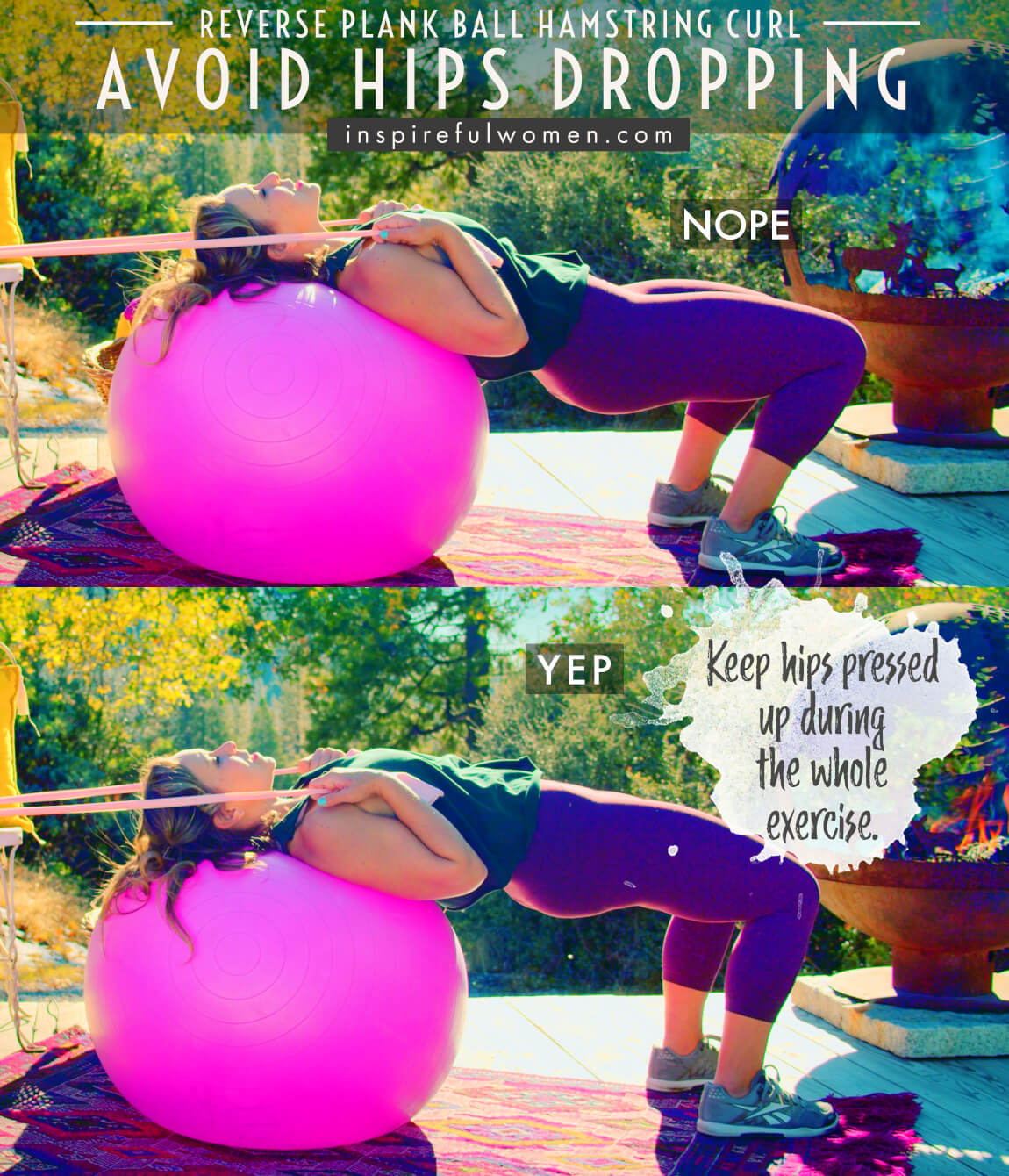
2. Avoid Head Dropping Down
AVOID: Avoid letting the head drop back.
WHY NOT?
- This can lead to neck muscle strain or damage to the cervical spine (neck) over time.
WHAT TO DO:
- If your head is not supported by the ball and you are unable to hold your neck in neutral
- Tuck your chin down a little bit.
- Limit the range of motion so that the neck stays supported on the ball.
- Do not use a resistance band and cradle your head in your hand(s).
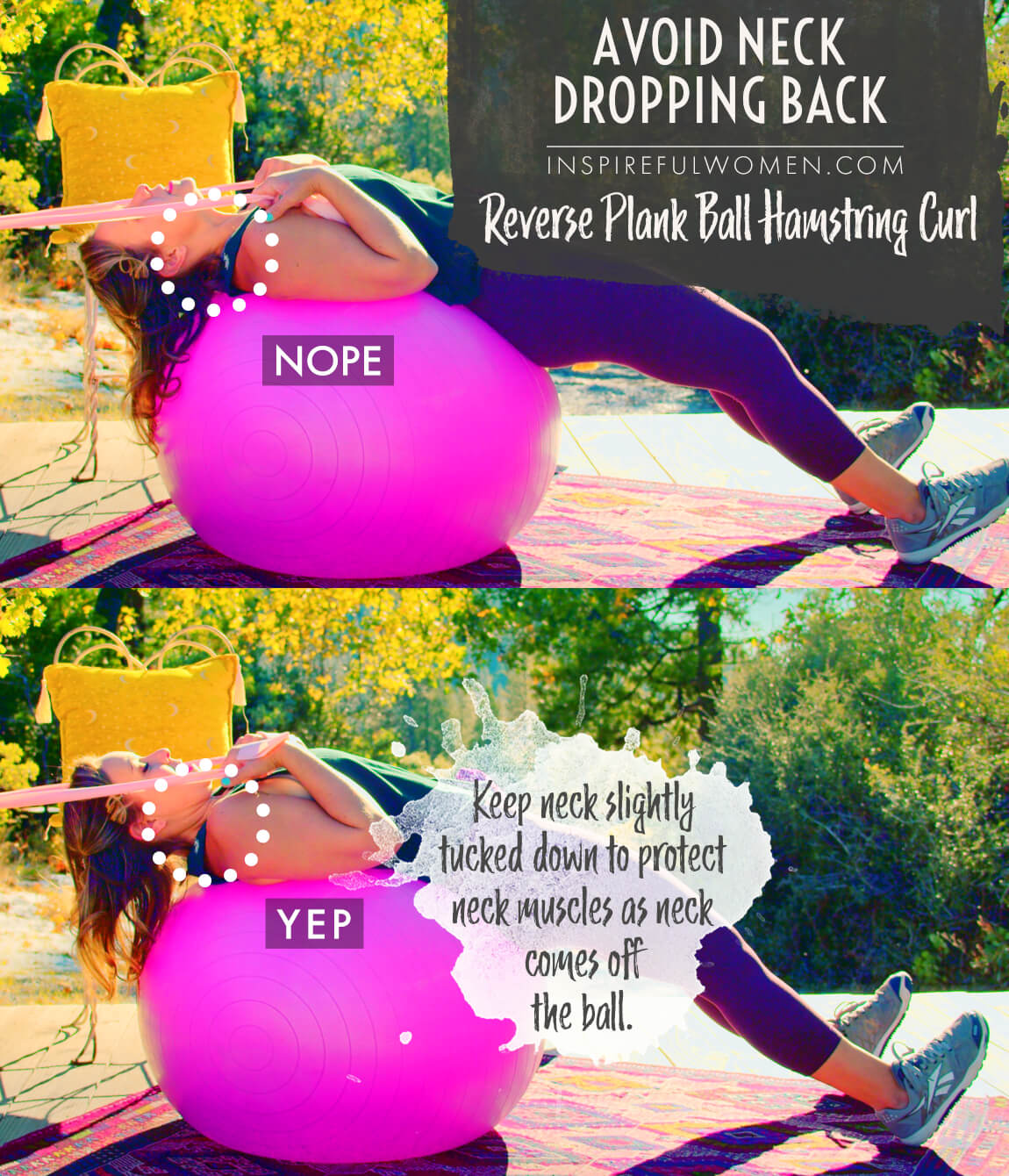
WHAT WE'RE DOING TODAY
WHAT & WHY
BENEFITS OF TRAINING THE HAMSTRINGS
WHAT
This is a creative ‘lil ditty of an exercise that will effectively target our hamstrings, and also get some glute max, calves & core stabilizers as free bonuses.
This hamstring exercise is done lying down face up on a stability ball with your feet on the floor. Using the hip extensors - the gluteus maximus and hamstrings, the pelvis is lifted up. Once you are in this reverse plank position, the hamstrings work to move the legs. The exercise will also work the gastrocnemius (one of the calf muscles) which crosses the knee joint and can help to bend the knee. The muscles of the core will need to stay engaged to keep the spine in a neutral position.
BRING THAT WEAKER LEG UP TO SPEED STRENGTH
A couple of nice things about this is that this exercise allows us to work each leg individually, which is good for both identifying weaknesses, & then working on them - most of us have a stronger & weaker leg. In double leg exercises, the stronger leg will often do more of the work without us even realizing it, while our weaker leg will keep coasting along getting Scott free. Single-leg moves force each leg to do its share of the work.
BIG MUSCLES REQUIRE BIG RESISTANCE TO GET STRONGER
If you used a toothbrush to do bicep curls in the bathroom, even if you did say, 50 reps, do you think you’re biceps would get bigger? Would your bicep muscle get fatigued? Most likely not, unless you’re a mouse. That might really do the job if you’re in the vermin family. Well, that’s kind of like what trying to exercise your legs at home is like.
Even though single-leg exercises are a really valuable way to address the above issue, & they are an effective way to make a home exercise actually hard enough to build muscle (where you don’t have weight machines & heavy weights like at the gym) - because remember these are big muscles we’re working, they need a lot of resistance to be trained effectively & that’s often a challenge to get at home.
So single leg exercise lets us do that, BUT……
HELP THE REST OF YOUR BODY HANDLE IT
The issue is, that most single-leg exercises are done in very challenging body positions that can be too difficult for your OTHER muscles to hold- your stabilizing core muscles & such, to hold with good form - at least when you are starting out. This exercise is a great way to train in a single-leg fashion with a bit more support from the ball for your torso/core muscles part of the time.
This version of stability ball hamstring curls uses body weight as the resistance. The instability of the ball and the addition of a slider and/or an elastic band for resistance can make these pretty challenging.
WHY BOTHER DOING IT?
WHY
WHY DO WE EVEN CARE?
TRAINING HAMSTRINGS WILL MAKE MONEY FALL FROM THE SKY.
Just kidding. HEALTHY KNEE ALIGNMENT
I had to attempt something a lot more interesting to catch your attention because somehow I feel like telling you that you’ll move with better knee alignment isn’t ALL that motivating.
Women’s knees are fairly vulnerable to injury because of the way we are shaped. Our hips tend to be wider than our knees, which can put uneven stresses on the knee joint. This makes it even more important for us to keep our hip and leg muscles strong and healthy, with a focus on good alignment and form during exercise. A healthy balance between the strength of the hamstrings and quadriceps, along with good motor control and coordination are needed to keep the knee in good alignment and stable as it moves.
BRING MUSCLE BALANCE TO OUR THIGHS/LEGS:
The quadriceps and hamstrings need to work together to control the movement of the legs. This is especially true for activities that involve running and stopping quickly and changing direction, for example in playing tennis or running after a feisty toddler. The setup of these two muscle groups is kind of like a game of tug of war. Imagine the quadriceps are on one side and the hamstrings on the other. If the quadriceps is too much stronger than the hamstrings the knee can be overextended and cause damage to the soft tissues of the joint (ligaments, meniscus).
Exercising on the stability ball works all of the stabilizing muscles of the core and legs more, especially when you are doing single-leg exercises. The knee is designed to be a very stable joint - voluntary movement of the knee is only in one plane - bending and straightening. The side-to-side movement of the knee is held stable by ligaments and the soft cartilage (meniscus). Over time wear and tear on these structures can result in the knee being less stable than it should be, increasing the risk of injury. Training the muscles to work together to help stabilize the joint can help to prevent further damage to the joint and lessen the risk of injury.
STOP LETTING THE GLUTES GET OUT OF DOING THEIR JOB.
The position of this exercise involves holding the low back and hips in a neutral position against the downward pull of gravity and the movement of the legs. The gluteus maximus needs to be very active just to hold the position as the hamstrings work to bend and straighten the knees. This is important because when the gluteus maximus is weak, the hamstrings can be overworked. The hamstrings try to do the job of the gluteus maximus. This can result in hamstring cramping, tendonitis, or even tears. Activating the gluteus maximus first and then the hamstrings can help to reinforce healthy patterns of muscle activation and reduce the risk of injury.
STOP LETTING THE GLUTES BLAME OTHER MUSCLES FOR WHY THEY AREN’T DOING THEIR JOB.
Sitting too much puts the muscles that work opposite the gluteus maximus, one of the hip flexors (iliopsoas) in a shortened position. This can lead to muscle tightness. A tight muscle on one side of a joint may inhibit or “turn off” the muscle on the opposite side of the joint - in this case, the hip extensors (gluteus maximus). This is known as reciprocal inhibition. When the gluteus maximus is inhibited the hamstrings need to work overtime to extend the hip. The position of this exercise lengthens the hip flexors while working the gluteus maximus.
EVERYDAY LIFE
EVERYDAY LIFE &
MUSCLE FUNCTION
HOW WE USE OUR HAMSTRINGS IN EVERYDAY LIFE
1. BEND (FLEXES) THE KNEE
- Pushing the elevated leg rest of a recliner down
- Scooting a chair into the table
- Pulling your foot back to tie your shoe
- Bending your knee to get into position to kick a ball
2. WORKS WITH THE GLUTEUS MAXIMUS TO MOVE THE LEG BACK (EXTEND THE HIP)
- Running up hills
- Walking up stairs
- Getting up from sitting - straightening the hip
- Walking up an incline- especially uphill
3. WORKS WITH THE QUADRICEPS TO CONTROL THE MOVEMENT OF THE LEG
- Walking
- Running
- Jumping
- Kicking
- Squatting
4. WORKS WITH THE QUADRICEPS TO KEEP THE KNEE AND HIP STABLE TO PROTECT THE JOINTS FROM DAMAGE DURING STANDING AND MOVING
- Standing
- Balancing
- Standing on a ladder with the weight on one leg to reach for painting/window washing
- Walking on ice or uneven surfaces
- Going up and down stairs
HOW TO FEEL WHAT MUSCLE IS WORKING
How to Feel What Muscle is Working
Sitting on the ball, feet flat on the floor. Move one foot forward a few inches and plant the heel on the floor. Place your hand under your thigh close to your knee. Push down hard into the floor with the heel of the front foot, like you are trying to pull the leg back. You should feel the muscles on the back of the thigh working.
SCIENCY STUFF
SCIENCY STUFF
SPIFFILICIOUS FACTS ABOUT MUSCLES & MOVES
The kneecap (patella) travels in a groove in the femur as the knee straightens and bends, the patella moves up and down. The patella is embedded in the quadriceps tendon. Its job is to increase the force the quadriceps can produce by acting as a pulley. The line of pull of the quadriceps muscle affects how the patella moves in the groove. This is known as the Q angle or quadriceps angle. It is measured by drawing a line through the center of the patella up to the anterior superior iliac spine (ASIS), which is the bony part of the front of the pelvis that tends to stick out a little bit, it is pretty easy to feel. Another line is drawn through the middle of the patella and the tibial tuberosity- this is the bony part of the tibia right below the patella - where the quadriceps tendon (or patellar tendon) attaches to the tibia. The angle that these two lines form is the Q angle. Larger angles (or wider hips) can cause the patella to ride on the side of the groove instead of in the groove. This can lead to knee pain and over time wear and tear (osteoarthritis) of the patellofemoral joint.
ALLLL MUSCLES & WHEN
ALL MUSCLES WORKING & WHEN DURING THE Ball Reverse Plank Hamstring Curl - Slider
The gluteus maximus and hamstrings contract concentrically to lift the pelvis up and isometrically to hold the starting position. The core stabilizers, especially the erector spinae will be working to hold the spine in neutral. The muscles of the lower legs are holding the ankles stable in a neutral position.
The hamstrings work concentrically to bend the knees. Both legs will be working the same way, but the leg that has the slider under the foot will not be able to provide as much help because of the decreased friction between the slider and the floor.
To return to the start position, the quadriceps work concentrically to straighten the knees. As the knees straighten, the head will become unsupported (off of the ball). At this point, the cervical flexors will work to hold the neck in a neutral position.
PIN IT FOR LATER!
